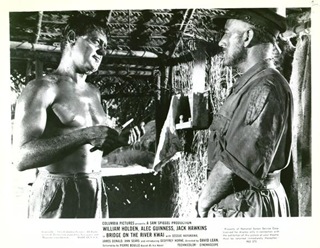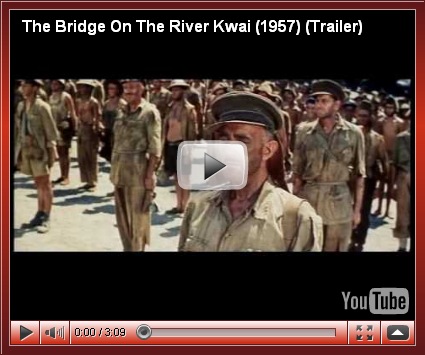MOVIE TRIVIA …
10 THINGS ABOUT
“THE BRIDGE
ON THE RIVER KWAI”
The Bridge on the River Kwai - 1957 - After settling his differences with a Japanese PoW camp commander, a British colonel co-operates to oversee his men's construction of a railway bridge for their captors - while oblivious to a plan by the Allies to destroy it.
The Bridge on the River Kwai was released in Australia on 8th March 1958.
1. Carl Foreman wrote the screenplay with Humphrey Bogart in mind for the role of Shears, but Columbia Studios head Harry Cohn refused to allow Bogart out of another project. Cary Grant then was briefly considered to star as Colonel Nicholson, but his flop in a serious role in Crisis (1950) concerned the producer, Sam Spiegel. The role was offered to Laurence Olivier who turned it down. Alec Guinness was the next choice.
2. The bridge cost $250,000 to build; construction began before anyone had been cast.
3. After the final scene was shot, producer Sam Spiegel shipped the film footage on five different planes to minimize the risk of loss.
4. The actual Major Saito, unlike the character portrayed in the film by Sessue Hayakawa, was said by some to be one of the most reasonable and humane of all of the Japanese officers, usually willing to negotiate with the POWs in return for their labour. Such was the respect between Saito and the real-life Lieutenant-Colonel Toosey that Toosey spoke up on Saito's behalf at the war-crimes tribunal after the war, saving him from the gallows. Ten years after Toosey's 1975 death, Saito made a pilgrimage to England to visit his grave.
5. The real life construction of the bridge over the River Kwai used about 100,000 conscripted Asian labourers. 12,000 prisoners of war died on the project.
6. William Holden, then a major star, was brought into the project to provide "box office appeal" after Cary Grant turned down the role. He received $300,000 up front, and was guaranteed a 10% share of the profits, to be paid at the rate of $50,000 a year. This is one reason why Holden sued to stop the first American TV showing of the film in 1966, claiming it would hurt future box office receipts, on which he was dependent (The lawsuit was unsuccessful). Because the film made so much money, his shares eventually accumulated to the point where the studio was making more off the interest on the unpaid balance than Holden was paid per year. A settlement was reached where Holden was paid a lump sum, and any future payments were willed to a motion picture relief fund.
7. Sessue Hayakawa edited his copy of the script to contain only his lines of dialog. This way, he remained oblivious to the real nature of his character's fate.
8. For the scene when Colonel Nicholson emerges from the oven after several days confined there, Alec Guinness based his faltering walk on that of his son Matthew when he was recovering from polio. Guinness regarded this one tiny scene as some of the finest work he did throughout his entire career.
9. At one point during filming, David Lean nearly drowned when he was swept away by a river current. Geoffrey Horne saved his life.
10. Sam Spiegel bought the railroad train from the Ceylonese government. It had previously belonged to an Indian maharajah and had seen 65 years of active service. Spiegel had it refurbished completely and then had one mile of railway track laid for it.





No comments:
Post a Comment